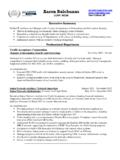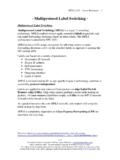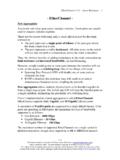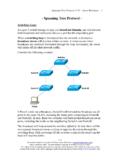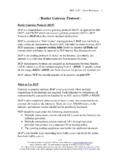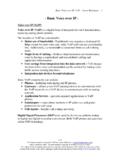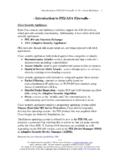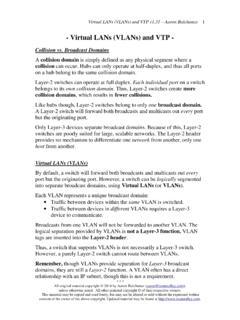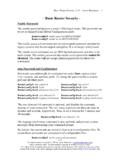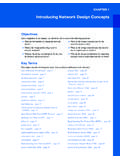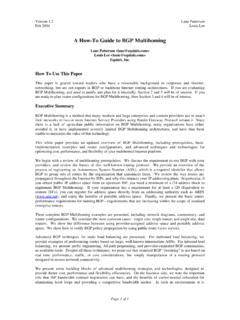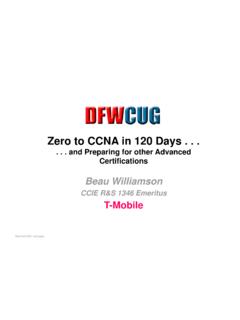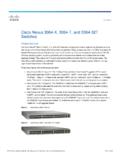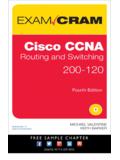Transcription of Open Shortest Path First - Router Alley
1 OSPF Aaron Balchunas * * * All original material copyright 2007 by Aaron Balchunas unless otherwise noted. All other material copyright of their respective owners. This material may be copied and used freely, but may not be altered or sold without the expressed written consent of the owner of the above copyright. Updated material may be found at 1 - open Shortest path First - OSPF ( open Shortest path First ) OSPF is a standardized Link-State routing protocol, designed to scale efficiently to support larger networks. OSPF adheres to the following Link State characteristics: OSPF employs a hierarchical network design using Areas. OSPF will form neighbor relationships with adjacent routers in the same Area. Instead of advertising the distance to connected networks, OSPF advertises the status of directly connected links using Link-State Advertisements (LSAs). OSPF sends updates (LSAs) when there is a change to one of its links, and will only send the change in the update.
2 LSAs are additionally refreshed every 30 minutes. OSPF traffic is multicast either to address (all OSPF routers) or (all Designated Routers). OSPF uses the Dijkstra Shortest path First algorithm to determine the Shortest path . OSPF is a classless protocol, and thus supports VLSMs. Other characteristics of OSPF include: OSPF supports only IP routing. OSPF routes have an administrative distance is 110. OSPF uses cost as its metric, which is computed based on the bandwidth of the link. OSPF has no hop-count limit. The OSPF process builds and maintains three separate tables: A neighbor table contains a list of all neighboring routers. A topology table contains a list of all possible routes to all known networks within an area. A routing table contains the best route for each known network. OSPF Aaron Balchunas * * * All original material copyright 2007 by Aaron Balchunas unless otherwise noted. All other material copyright of their respective owners.
3 This material may be copied and used freely, but may not be altered or sold without the expressed written consent of the owner of the above copyright. Updated material may be found at 2 OSPF Neighbors OSPF forms neighbor relationships, called adjacencies, with other routers in the same Area by exchanging Hello packets to multicast address Only after an adjacency is formed can routers share routing information. Each OSPF Router is identified by a unique Router ID. The Router ID can be determined in one of three ways: The Router ID can be manually specified. If not manually specified, the highest IP address configured on any Loopback interface on the Router will become the Router ID. If no loopback interface exists, the highest IP address configured on any Physical interface will become the Router ID. By default, Hello packets are sent out OSPF-enabled interfaces every 10 seconds for broadcast and point-to-point interfaces, and 30 seconds for non-broadcast and point-to-multipoint interfaces.
4 OSPF also has a Dead Interval, which indicates how long a Router will wait without hearing any hellos before announcing a neighbor as down. Default for the Dead Interval is 40 seconds for broadcast and point-to-point interfaces, and 120 seconds for non-broadcast and point-to-multipoint interfaces. Notice that, by default, the dead interval timer is four times the Hello interval. These timers can be adjusted on a per interface basis: Router (config-if)# ip ospf hello-interval 15 Router (config-if)# ip ospf dead-interval 60 OSPF Aaron Balchunas * * * All original material copyright 2007 by Aaron Balchunas unless otherwise noted. All other material copyright of their respective owners. This material may be copied and used freely, but may not be altered or sold without the expressed written consent of the owner of the above copyright. Updated material may be found at 3 OSPF Neighbors (continued) OSPF routers will only become neighbors if the following parameters within a Hello packet are identical on each Router : Area ID Area Type (stub, NSSA, etc.)
5 Prefix Subnet Mask Hello Interval Dead Interval Network Type (broadcast, point-to-point, etc.) Authentication The Hello packets also serve as keepalives to allow routers to quickly discover if a neighbor is down. Hello packets also contain a neighbor field that lists the Router IDs of all neighbors the Router is connected to. A neighbor table is constructed from the OSPF Hello packets, which includes the following information: The Router ID of each neighboring Router The current state of each neighboring Router The interface directly connecting to each neighbor The IP address of the remote interface of each neighbor (Reference: ) OSPF Aaron Balchunas * * * All original material copyright 2007 by Aaron Balchunas unless otherwise noted. All other material copyright of their respective owners. This material may be copied and used freely, but may not be altered or sold without the expressed written consent of the owner of the above copyright.
6 Updated material may be found at 4 OSPF Designated Routers In multi-access networks such as Ethernet, there is the possibility of many neighbor relationships on the same physical segment. In the above example, four routers are connected into the same multi-access segment. Using the following formula (where n is the number of routers): n(n-1)/2 ..it is apparent that 6 separate adjacencies are needed for a fully meshed network. Increase the number of routers to five, and 10 separate adjacencies would be required. This leads to a considerable amount of unnecessary Link State Advertisement (LSA) traffic. If a link off of Router A were to fail, it would flood this information to all neighbors. Each neighbor, in turn, would then flood that same information to all other neighbors. This is a waste of bandwidth and processor load. To prevent this, OSPF will elect a Designated Router (DR) for each multi-access networks, accessed via multicast address For redundancy purposes, a Backup Designated Router (BDR) is also elected.
7 OSPF routers will form adjacencies with the DR and BDR. If a change occurs to a link, the update is forwarded only to the DR, which then forwards it to all other routers. This greatly reduces the flooding of LSAs. DR and BDR elections are determined by a Router s OSPF priority, which is configured on a per-interface basis (a Router can have interfaces in multiple multi-access networks). The Router with the highest priority becomes the DR; second highest becomes the BDR. If there is a tie in priority, whichever Router has the highest Router ID will become the DR. To change the priority on an interface: Router (config-if)# ip ospf priority 125 Default priority on Cisco routers is 1. A priority of 0 will prevent the Router from being elected DR or BDR. Note: The DR election process is not preemptive. Thus, if a Router with a higher priority is added to the network, it will not automatically supplant an existing DR. Thus, a Router that should never become the DR should always have its priority set to 0.
8 OSPF Aaron Balchunas * * * All original material copyright 2007 by Aaron Balchunas unless otherwise noted. All other material copyright of their respective owners. This material may be copied and used freely, but may not be altered or sold without the expressed written consent of the owner of the above copyright. Updated material may be found at 5 OSPF Neighbor States Neighbor adjacencies will progress through several states, including: Down indicates that no Hellos have been heard from the neighboring Router . Init indicates a Hello packet has been heard from the neighbor, but two-way communication has not yet been initialized. 2-Way indicates that bidirectional communication has been established. Recall that Hello packets contain a neighbor field. Thus, communication is considered 2-Way once a Router sees its own Router ID in its neighbor s Hello Packet. Designated and Backup Designated Routers are elected at this stage.
9 ExStart indicates that the routers are preparing to share link state information. Master/slave relationships are formed between routers to determine who will begin the exchange. Exchange indicates that the routers are exchanging Database Descriptors (DBDs). DBDs contain a description of the Router s Topology Database. A Router will examine a neighbor s DBD to determine if it has information to share. Loading indicates the routers are finally exchanging Link State Advertisements, containing information about all links connected to each Router . Essentially, routers are sharing their topology tables with each other. Full indicates that the routers are fully synchronized. The topology table of all routers in the area should now be identical. Depending on the role of the neighbor, the state may appear as: Full/DR indicating that the neighbor is a Designated Router (DR) Full/BDR indicating that the neighbor is a Backup Designated Router (BDR) Full/DROther indicating that the neighbor is neither the DR or BDR On a multi-access network, OSPF routers will only form Full adjacencies with DRs and BDRs.
10 Non-DRs and non-BDRs will still form adjacencies, but will remain in a 2-Way State. This is normal OSPF behavior. OSPF Aaron Balchunas * * * All original material copyright 2007 by Aaron Balchunas unless otherwise noted. All other material copyright of their respective owners. This material may be copied and used freely, but may not be altered or sold without the expressed written consent of the owner of the above copyright. Updated material may be found at 6 OSPF Network Types OSPF s functionality is different across several different network topology types. OSPF s interaction with Frame Relay will be explained in another section Broadcast Multi-Access indicates a topology where broadcast occurs. Examples include Ethernet, Token Ring, and ATM. OSPF will elect DRs and BDRs. Traffic to DRs and BDRs is multicast to Traffic from DRs and BDRs to other routers is multicast to Neighbors do not need to be manually specified.

